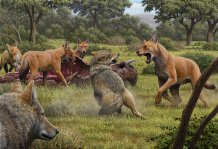Articles

Canis dirus scene color Credit Mauricio Antón
Ancient DNA reveals secrets of Game of Thrones wolves
An extinct species of wolf made famous in the TV show Game of Thrones split off from others nearly six million years ago and are only a distant relative of today’s wolves, researchers have found.
Dire wolves were common across North America until around 13,000 years ago, after which they went extinct.
The study shows that dire wolves were so different from other canine species like coyotes and grey wolves that they were not able to breed with each other. Previous analyses, based on morphology alone, had led scientists to believe that dire wolves were closely related to grey wolves.
The research was led by Durham University in the UK alongside scientists at Ludwig Maximilian University in Germany, the University of Adelaide in Australia, the University of California Los Angeles in the US and the University of Exeter.
The international team has sequenced the ancient DNA of five dire wolf sub-fossils from Wyoming, Idaho, Ohio, and Tennessee, dating back to over 50,000 years ago. Their analyses showed that dire wolves and grey wolves were in fact very distant cousins.
This is the first time ancient DNA has been taken from dire wolves revealing a complex history of these ice age predators.
Dr Carly Ameen, an archaeologist from the University of Exeter who was involved in the research, said: “For me, this work really highlights how we need to be careful regarding our assumptions about species’ relationships based on only one strand of data. While the grey wolf and the dire wolf were morphologically very similar, our work here shows this does not extend to their genetic relationship.
“It is important that we bring all available lines of evidence together for analyses, rather than conduct work in isolation. This is especially true when we are considering extinct species, where the temptation is much higher to compare them to a living example, which might not accurately reflect their biological relationships.”
The team, of 49 researchers across nine countries, analysed the genomes of dire wolves alongside those of many different wolf-like canid species. Their analyses suggest that unlike many canid species who apparently migrated repeatedly between North America and Eurasia over time, dire wolves evolved solely in North America for millions of years.
Although dire wolves overlapped with coyotes and grey wolves in North America for at least 10,000 years before their extinction, they found no evidence that they interbred with these species. The researchers suggest that their deep evolutionary differences meant that they were likely ill equipped to adapt to changing conditions at the end of the ice age.
Lead author, Dr Angela Perri from Durham University’s Archaeology Department, said: "Dire wolves have always been an iconic representation of the last ice age in the Americas and now a pop culture icon thanks to Game of Thrones, but what we know about their evolutionary history has been limited to what we can see from the size and shape of their bones and teeth.
“With this first ancient DNA analysis of dire wolves we have revealed that the history of dire wolves we thought we knew - particularly a close relationship to grey wolves - is actually much more complicated than we previously thought.
“Instead of being closely related to other North American canids, like grey wolves and coyotes, we found that dire wolves represent a branch that split off from others millions of years ago, representing the last of a now extinct lineage."
Co-lead author, Dr Alice Mouton, from the University of California Los Angeles, added: “We have found the dire wolf is not closely related to the grey wolf. Further we show that the dire wolf never interbred with the grey wolf. In contrast, grey wolves, African golden wolves, dogs, coyotes and jackals can and do interbreed. Dire wolves likely diverged from grey wolves more than five million years ago, which was a great surprise that this divergence occurred so early. This finding highlights how special and unique the dire wolf was.”
The dire wolf is one of the most famous prehistoric carnivores from Pleistocene America which became extinct around 13,000 years ago. Known scientifically as Canis dirus, meaning ’fearsome dog’, they preyed on large mammals like bison. The team suggests the dire wolves’ stark evolutionary divergence from grey wolves places them in an entirely different genus - Aenocyon dirus (‘terrible wolf’)- as first proposed by palaeontologist John Campbell Merriam over 100 years ago.
Co-lead author, Dr Kieren Mitchell, from the University of Adelaide, commented: "Dire wolves are sometimes portrayed as mythical creatures - giant wolves prowling bleak frozen landscapes - but reality turns out to be even more interesting.
"Despite anatomical similarities between grey wolves and dire wolves - suggesting that they could perhaps be related in the same way as modern humans and Neanderthals - our genetic results show these two species of wolf are much more like distant cousins, like humans and chimpanzees.
"While ancient humans and Neanderthals appear to have interbred, as do modern grey wolves and coyotes, our genetic data provided no evidence that dire wolves interbred with any living canine species. All our data point to the dire wolf being the last surviving member of an ancient lineage distinct from all living canines."
Senior author, Dr Laurent Frantz, from the Ludwig Maximilian University of Munich, added: “When we first started this study we thought that dire wolves were just beefed up grey wolves, so we were surprised to learn how extremely genetically different they were, so much so that they likely could not have interbred. Hybridisation across Canis species is thought to be very common, this must mean that dire wolves were isolated in North America for a very long time to become so genetically distinct”
Date: 13 January 2021
